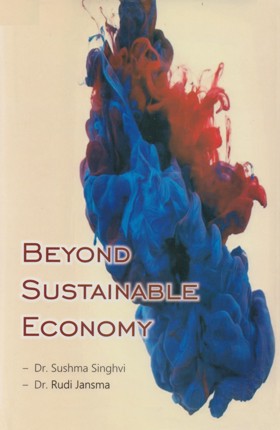Dr. Sushma Singhvi[1]
The environment and economics have been mutually interrelated since ancient time.
The concern for protection of the environment is noticed in Kautilya's economics in his book the Arthaśastra.[2] He has give given two meanings of the word 'artha': (1) livelihood of human being is 'artha': 'manuṣyāṇāṁ vṛttiḥ iti arthaḥ' (2) the earth including its human beings is 'artha': (manuṣyavatī bhūmiḥ iti arthaḥ), therefore the efforts for guarding and nourishing the earth and obtaining the benefits of the earth for human beings can be called 'economics'. From this point of view the environment and economics have been mutually interrelated since ancient time.
The question of environment is related to the process of modern production, over which the entire economy and political structure is based. Producers have to be vigilant for environmental morality. Overproduction and overconsumption hamper environmental morality. Man has to regard himself as a part of nature or one of the units of nature and protect the environment. The human being is a developed creature than other vegetation to four-sensed creatures, hence he should feel more responsibility towards under-developed creatures rather than feeling ownership or superiority over them.
Environmental moral policy scholars, from ancient to the modern times have advised the protection of nature, birds, animals and their right to life and liberty. Environmental activists have opined that heavy industrialization and excessive consumerism are leaving dangerous effects on natural environment and creating environment pollution. Examples of famous writers and their key works in this field of the twentieth century are:
Rachel Carson Silent Spring (1967) [3]
Fritz Schumacher Small is Beautiful (1973) [4]
Peter Singer Animal Liberation (1975) [5]
Club of Rome Report for the Club of Rome: The Limits to Growth (1972) [6]
Aldo Leopold Land Ethic (1949) [7]
Arne Naess Ecology, Community and Life Style (1990) [8]
James Lovelock Gaia (1975, 1979) [9]
These works of environmental science have awakened our moral responsibility towards the plant and the animal kingdoms.
Silent Spring (1967) has documented the detrimental effects on the environment, particularly on birds, due to the excessive use of pesticides.
Animal Liberation (1975) by Peter Singer has been called 'the bible of the animal liberation movement'. From an utilitarian and atheistic point of view he expands the concept or 'rights' to all that lives.
The Limits to Growth, written for the Club of Rome and published in 1972, is about a computer simulation of exponential economic and population growth with finite resources. It discussed the growth of world population, industrialization, pollution, food production and resources depletion. These variables are considered to grow exponentially, while the ability of technology to increase resources availability is only linear. The authors noted that their projections for the values of the variables in each scenario were predictions "only in the most limited sense of the word," and were only indications of the system's behavioral tendencies. The indication were often on the pessimistic side, what resulted in heavy criticizing and rejection by industrialists who earn their money in the mentioned resources.
Land Ethic by Aldo Leopold is on environmental philosophy in the sense that it directs individuals to include plants, soils, waters, and animals: land in human community and this book - guides us for modern conservation movement. According to Aldo Leopold economic wellbeing can not be separated from environment and ecological wellbeing. He wrote that there is a need for a 'new ethic,' an 'ethic dealing with human's relation to land and to the animals and plants which grow upon it.'
Arne Naess in his article "The Shallow and the Deep, Long-Range Ecology Movement." in Inquiry 16: 95-100, 1973 and his book Ecology, Community and Life Style: Ouline of an Ecosophy has coined the term 'deep ecology' (as opposed to mainstream ecology which he called 'shallow ecology'. As defined in Wikipedia, deep ecology is an ecological and environmental philosophy characterized by its advocacy of the inherent worth of living beings regardless of their instrumental utility to human needs, and advocacy for a radical restructuring of modern human societies in accordance with such ideas. The utilitarian pragmatism of business is based on shallow ecological thinking in contrast to the natural environmental 'deep ecological' thinking. In his philosophical approach, named Ecosophy he envisions that in distinction to realization of man's narrow selves, the realization of our selves as part of an 'ecospheric whole' is a deeper and more universal approach. It is in this whole that our true ecological Self can be realized. He combined his ecological vision with the Gandhian non-violence model. He appreciated biological diversity and explained the interdependence of living beings. Every being, whether human, animal or vegetable has an equal right to live and to blossom. Naess remarks that nature works in a cyclic form of production and use, where in, the consumption of a natural production releases waste matter which again becomes reproductive. However in the capitalistic system, production is only in one direction, which is called 'development'. In this system the large amount of waste matter is neither reproductive nor re-usable, in the absence of proper technique. Thus by the excess of production, the capacity of the earth to bear the burden gets abated.
Gaia: A New Look at Life on Earth by James Lovelock is about the Gaia theory, (originally proposed by James Lovelock in The New Scientist together with Sidney Epton) and was presented in popular form in his first popular book 1979 (2000) and has made clear that the planet is a self-sustaining whole in which even micro-organisms play a crucial role in maintaining the balance of the Earth's atmosphere and that the earth can be compared to a gigantic 'living?' entity sustained and kept in balance by a great complexity of homeostatic process in which its living organisms play, though unawares to themselves, an continuous active role. We can not do harm to one specific aspect of the planet's functioning without affecting all others - including seemingly unrelated parameters. As restoring and maintaining equilibrium belongs to the very character of the earth, those who cause harm will also suffer harm to themselves due to the natural processes of rebalancing. As a chemical researcher he brought the effects of CFK's[10], their origin and its omnipresence in the global atmosphere and the mechanism behind the natural balance carbondioxide (CO2) and other components of the planet to attention. Ozone 'holes' (local depletion of O3 in the upper layers of the atmosphere) and global warming are clear examples of how things can go wrong.
In our present reference to the context, the meaning of non-possessiveness is related to the concept of 'no overexploitation of nature' and by the 'co-operation between nature and man' the tendency of possessiveness and hoarding can be limited. Umāsvāti, the author of the book Tattvārtha Sūtra, about 2000 years ago, has hinted at the interdependence between living beings: parasparopagraho jīvānāṁ (Tattvārtha Sūtra 5.21).
The Veda by saying 'yasyāṁ vṛkśā vānaspatyā dhruvāstiṣṭhanti viṣvahā' (Atharvaveda, 12.1.27) exhorts that with trees and vegetation all around, the life of all living beings is secure.
As such, we should take from the nature as much as we can restore. In the Atharvaveda, a prayer is observed for restoration while mining -
yat te bhūme vikhanāmi kśipraṁ tadapi rohatu
mā te marma vimṛgvari mā te hṛdayamarpipam
(Atharvaveda 12.1.35)
i.e. "O Lord!, this mining should restore soon. I don't want to extract the heart of the mines."
The Veda announces that the earth is the mother of all living beings and we all are her sons (children): 'mātā bhūmiḥ putro'hāṁ pṛthivyāḥ' (Atharvaveda, 12.1.12).
As such, the use of resources received from the mother is justified, but accumulation, exploitation, excessive consumerism; ownership is not acceptable in any way. From this point of view, non-possessiveness is an excellent principle with regard to environmental protection and ecological balance.
Non-possessiveness is voluntary and as such a limitation of resources and property for one's own use is also voluntary; i.e. aparigraha or renunciation by thought, word (speech) and deed. It means: a livelihood with the least disturbance to nature and fellow beings; a citizenship like a part of the whole cosmos; friendship with all living beings including land-earth, air, water and energy; society with limited possession for sustaining life, without ownership of living or non-living substances are the core structure of non-possessiveness which is beyond sustainable economy.
I am happy now, I could and can believe that the essence and secret of happiness is non-possessiveness and wantlessness, which is beyond desires, hoardings, consumerism and capitalism.
Emeritus Prof., Deptt. of Languages and Oriental Studies, Jain Vishva Bharati Institute (deemed University), Ladnun, Rajasthan; Director, Reseach, Prakrit Bharati Academy, Jaipur. Ex Chair Person, Rajasthan Sanskrit Academy, Deptt. of Art, Literature, Culture and Tourism, Govt. of Rajastan, Jaipur
The Arthaśastra of Kautilya is an ancient Hindu treatise on statecraft, economic policy and military strategy. Kautilya has also been identified as Vishnugupta and Chanakya. Of Chanakya is known that he was a scholar at Tak¼aśilå University (site near present-day Rawalpindi in Pakistan which probably already existed 6 centuries BCE. He was the teacher and guardian of Emperor Chandragupta Maurya (c. 340 - c. 297 BCE). The Arthaśastra would then be composed, expanded and redacted in the 2nd and 3rd century CE.
Ernst Friedrich "Fritz" Schumacher (19 August 1911 4 September 1977): Small Is Beautiful: A Study of Economics As If People Mattered. Blond & Briggs (1973-2010), HarperCollins (2010-present), 1973
Peter Albert David Singer, (born 6 July 1946): Animal Liberation: A New Ethics for Our Treatment of Animals is a 1975. HarperCollins, 1975 (1990, 2002, 2009).
Donella H. Meadows, Dennis L. Meadows, Jørgen Randers, and William W. Behrens III: Limits to the Growth. A Report for the Club of Rome for the Predicament of Mankind. Universe Books, 1972.
Aldo Leopold (18871948) A Sand County Almanac: and sketches here and there. Oxford University Press, 1949).
Arne Dekke Eide Naess (27 January 1912 12 January 2009) 'The Shallow and the Deep, Long-Range Ecology Movement." in Inquiry 16: 95-100, 1973 and Ecology, Community and Life Style: Outline of an Ecosophy. Cambridge University Press, 1990.
James Ephraim Lovelock (born 1919): Lovelock, James & Sidney Epton. "The Quest for Gaia". New Scientist 65 (935): 304, 1975 (retrieved on 10 April 2014), and Gaia: A New Look at Life on Earth (3rd ed.). Oxford University Press (1979) 2000.
CFKs or Chlorofluorocarbons are defined as any of a class of compounds of carbon, hydrogen, chlorine, and fluorine, typically gases used in refrigerants and aerosol propellants. They are harmful to the ozone layer in the earth's atmosphere owing to the release of chlorine atoms on exposure to ultraviolet radiation.
 Dr. Rudi Jansma
Dr. Rudi Jansma
 Dr. Sushma Singhvi
Dr. Sushma Singhvi
